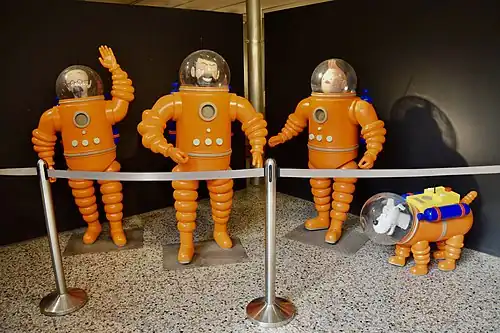Belgian Comic Strip Center
_20230826.jpg) Exterior of the museum | |
Interactive fullscreen map | |
| Established | 6 October 1989[1] |
|---|---|
| Location | Rue des Sables / Zandstraat 20, 1000 City of Brussels, Brussels-Capital Region, Belgium |
| Coordinates | 50°51′04″N 4°21′36″E / 50.85111°N 4.36000°E |
| Type | History of Belgian comics |
| Visitors | More than 200,000 per year[1] |
| Public transit access | |
| Website | www |
The Belgian Comic Strip Center (French: Centre Belge de la Bande Dessinée; Dutch: Belgisch Stripcentrum) is a museum in central Brussels, Belgium, dedicated to Belgian comics. It is located at 20, rue des Sables/Zandstraat, in an Art Nouveau building designed by Victor Horta, and can be accessed from Brussels-Congress railway station and Brussels-Central railway station.
History
In 1906, the building that would later house the Belgian Comic Strip Center was inaugurated as the Waucquez Warehouse, designed by architect Victor Horta to serve textile baron Charles Waucquez. This period, in the late nineteenth to early twentieth century, coincided with the beginnings of modern comic strips.[2]
By 1975, architect Jean Delhaye, a student of Horta, brought the endangered Waucquez Warehouse to the attention of the state, and the building was listed. In 1980, architect Jean Breydel and comics artists François Schuiten, Bob de Moor, Alain Baran, Guy Dessicy, and Hergé planned to restore the warehouse and give it a new role as a museum dedicated to the history of Belgian comics. Originally, the museum would be a homage to Hergé, but he suggested honouring the entire Belgian comics industry.[3][2]
In 1983, the Minister of Public Works purchased the warehouse from the owners’ heirs to secure the building and dedicate it to promoting comic strips. In 1984, the “Belgian Comic Strip Center” was founded as a non-profit organisation, with Bob De Moor as its first chairman. A fund was established bringing together Flemish and Walloon comics artists.[2]
In 1986, the launch of the project was celebrated, despite the building still being in ruins. Intensive lobbying, including a luncheon at the Royal Palace and a soirée with the Belgian comic strip community, helped secure the project. Restoration work began in 1987, coordinated by architect Christian Lelubre and executed by Pierre Van Assche, who designed the plans respecting Horta’s original work. The restorations included updating the building to modern standards, while mosaics were imported from Italy and constructed by Italian mosaic workers due to the profession being largely obsolete in Belgium.[3][2]
On 6 October 1989, the museum was officially inaugurated in the presence of King Baudouin and Queen Fabiola.[4] Over the following decades, the Belgian Comic Strip Center became a major museum with international appeal, welcoming around 200,000 visitors annually, while government subsidies accounted for less than 10% of its working budget. By 2015, the museum began redecorating its permanent exhibition, continuing its mission as a promotional tool, exhibition venue, research centre, and cultural ambassador for Belgian comics and Art Nouveau architecture.[5]
Since 2009, directly across the street from the Belgian Comic Strip Center, another comics-themed museum opened, the Marc Sleen Museum, dedicated to the work of Belgian comics artist Marc Sleen. On 30 January 2023, it was announced that the museum would close in the autumn, with part of its collection being integrated into the Belgian Comic Strip Center.[6][7][8]
-
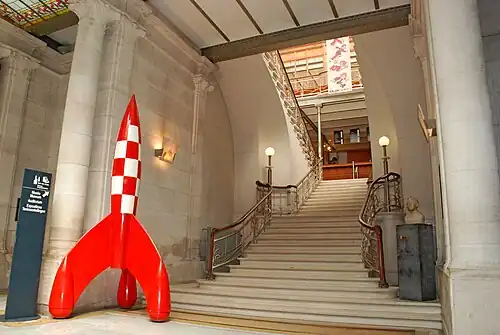 Entrance staircase
Entrance staircase -
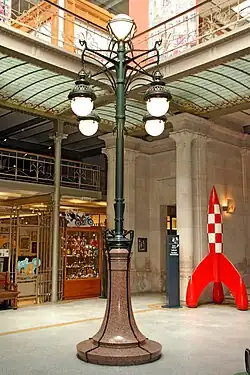 Art Nouveau lamppost
Art Nouveau lamppost -
 Main skylight on the second floor
Main skylight on the second floor -
 Second floor
Second floor
Building
The Waucquez Warehouse was designed in 1905 by Victor Horta in Art Nouveau style and completed in 1906 as a textile department store. It is the only surviving example of a series of Horta’s department stores, notable for its use of iron and glass, a central atrium, and a monumental staircase. The building was protected as a monument in 1975 and renovated in 1988–1989 to restore its architectural details while adapting it for public use.[3][9]
The structure is rectangular, with two storeys under a low-pitched roof and two large glass domes. The façade is symmetrical, slightly concave, and built from natural stone, with vertical pilasters forming curved arches above the main openings. Doors and windows were restored to their original designs, with wrought iron guards on the ground floor and decorative railings above.[9]
The interior is open-plan with two main levels and a mezzanine, featuring exposed I-beams on cast iron columns, vaulted ceilings, and decorative elements such as marble mosaic floors, stained glass, and a monumental stone staircase with iron railings. The ground floor houses a restaurant, a room dedicated to Victor Horta, a comics store, a library, and a reading room, while the upper floors contain a permanent exhibition on the history of Belgian comics and spaces for temporary exhibitions.[3][9]
-
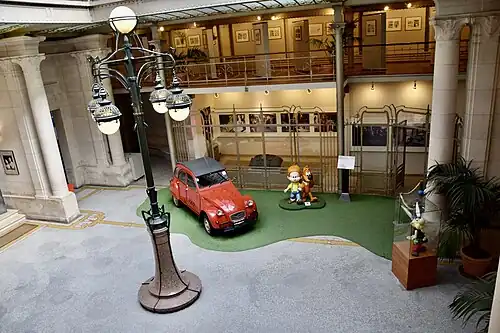 Entrance hall
Entrance hall -
 Library
Library -
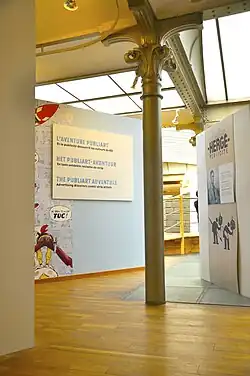 Entrance to the PUBLIART space
Entrance to the PUBLIART space -
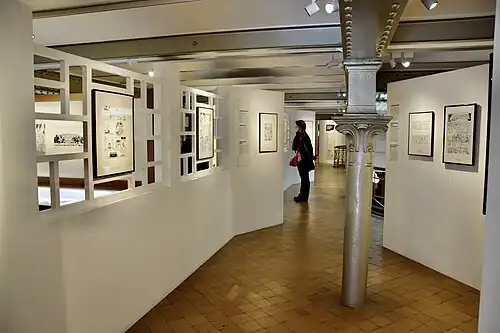 Exhibition space
Exhibition space
List of the exhibited comics artists
Four artists exhibited are Flemish: Willy Vandersteen, Marc Sleen, Bob de Moor and Morris. The rest are Walloon or from Brussels, except for Jacques Martin and Tibet who were born in France, but published in Tintin.
- Hergé - (The Adventures of Tintin, Quick and Flupke, Jo, Zette and Jocko)
- Jijé - (Spirou et Fantasio, Jerry Spring)
- Edgar P. Jacobs - (Blake and Mortimer)
- Willy Vandersteen - (Suske en Wiske)
- Marc Sleen - (The Adventures of Nero)
- Maurice Tillieux - (Gil Jourdan)
- Bob De Moor - (Cori, de Scheepsjongen)
- André Franquin - (Spirou et Fantasio, Marsupilami, Gaston Lagaffe, Franquin's Last Laugh)
- Jacques Martin - (The Adventures of Alix)
- Morris - (Lucky Luke)
- Paul Cuvelier - (Corentin)
- Victor Hubinon - (Buck Danny)
- Tibet - (Chick Bill, Ric Hochet)
- Raymond Macherot - (Chlorophylle, Sybilline)
- Jean Roba - (Boule et Bill)
- Peyo - (Johan and Peewit, The Smurfs)
See also
- List of museums in Brussels
- Brussels' Comic Book Route
- Art Nouveau in Brussels
- History of Brussels
- Culture of Belgium
- Belgium in the long nineteenth century
References
Citations
- ^ a b "About Us—In Short". Brussels, Belgium: Belgian Comic Strip Center. Retrieved 4 July 2011.
- ^ a b c d "A masterpiece of Art Nouveau". Comics Art Museum.
{{cite web}}: CS1 maint: url-status (link) - ^ a b c d "Belgisch Centrum van het Beeldverhaal Brussel" [Belgian Comic Strip Center Brussels] (PDF). Openbaar Kunstbezit Vlaanderen (in Dutch). Archived from the original (PDF) on 22 December 2015. Retrieved 7 November 2015.
- ^ "Belgian Comic Strip Center". City of Brussels. Archived from the original on 24 September 2014. Retrieved 21 September 2014.
- ^ "De Hergéruimte" [The Hergé Room]. Stripmuseum Brussel (in Dutch). Archived from the original on 11 April 2021. Retrieved 7 November 2015.
- ^ "Einde verhaal voor Marc Sleen Museum".
- ^ "Marc Sleen Museum wordt onderdeel van het Belgisch Stripcentrum". Het Laatste Nieuws (in Dutch). 31 January 2023. Retrieved 17 November 2023.
- ^ "Marc Sleen Museum stopt en wordt onderdeel van Stripmuseum Brussel". 31 January 2023.
- ^ a b c "Voormalig warenhuis Waucquez / Belgisch Centrum van het Beeldverhaal – Inventaris van het bouwkundig erfgoed". monument.heritage.brussels (in Dutch). Retrieved 20 August 2025.
Bibliography
- Geert De Weyer, België gestript (in Dutch), Lannoo, Tielt (2005), p. 77–78 (ISBN 978-9-462-10202-6)
- Le Patrimoine monumental de la Belgique: Bruxelles (PDF) (in French). Vol. 1C: Pentagone N-Z. Liège: Pierre Mardaga. 1994. pp. 268–270.
External links
 Media related to Belgian Centre for Comic Strip Art at Wikimedia Commons
Media related to Belgian Centre for Comic Strip Art at Wikimedia Commons- Official website


